
Dispur is the capital of the Indian state of Assam and is a sub-urban locality located at Guwahati.

Guwahati is the biggest city of the Indian state of Assam and also the largest metropolis in northeastern India. Dispur, the capital of Assam, is in the circuit city region located within Guwahati and is the seat of the Government of Assam. A major riverine port city along with hills, and one of the fastest growing cities in India, Guwahati is situated on the south bank of the Brahmaputra. It is called the ''Gateway to North East India''.

The Kamakhya Temple is a Hindu temple at Nilachal hills in Guwahati, Assam. Dedicated to the mother goddess Kamakhya, it is one of the oldest and most revered centres of Tantric practices. The temple is the center of the Kulachara Tantra Marga and the site of the Ambubachi Mela, an annual festival that celebrates the menstruation of the goddess. Structurally, the temple is dated to the 8th-9th century with many subsequent rebuildings—and the final hybrid architecture defines a local style called Nilachal. It is also one of the oldest of the 51 pithas in the Shakta tradition. An obscure place of worship for much of history it became an important pilgrimage destination, especially for those from Bengal, in the 19th century during colonial rule.
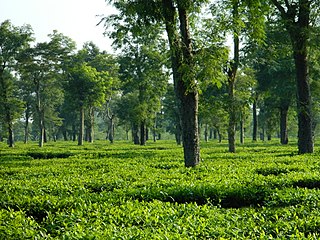
Dibrugarh is an city in Upper Assam with sprawling tea gardens. Located 435 km East from the state capital Dispur. It serves as the headquarters of Dibrugarh district in the state of Assam in India. Dibrugarh serves as the headquarters of the Sonowal Kachari Autonomous Council, which is the governing council of the Sonowal Kachari tribe. Currently, the city Master Plan area of Dibrugarh is 71.83 km² and population is 154,296. Dibrugarh railway station under the Tinsukia railway division of Northeast Frontier Railway Zone acts as the top largest Railway Junction in entire Northeast India.
Biswanath Chariali is a city and a municipal board in Biswanath district in the state of Assam, India. This city is the district headquarters of Biswanath district, which was created on 15 August 2015. It derives its name from Biswanath Ghat.

North Guwahati is northern part of the city of Guwahati and a town area committee in Kamrup Rural district in the Indian state of Assam.This town abounds in historical places and picnic spots. National Highway 27 passes through North Guwahati. Amingaon neighbourhood is district headquarter of Kamrup Rural district.

Hajo is a historic town set in the hills northwest of Guwahati, Assam, India. Meeting point of Buddhism, Hinduism and Islam. The different hills of Hajo are a pilgrimage site for regional Hindus, Buddhists, and Muslims. To the Hindus, the Manikut Parbat of Hajo is the site of the 10th-century temple ruins and the 11th- to 16th-century temples complex for Vaishnavism as well as shrines of Shaivism and Shaktism. To the Buddhists, particularly from Bhutan and Tibet, Assam is where the Buddha died and the Hyagriva temple in Hajo is a part of the sacred geography of the Buddha. To the regional Muslims, the Mughal era Poa-Mecca shrine on another hill of Hajo has the tomb of Giyasuddin Aulia built in the 17th-century.

Umananda Devaloi is a Shiva temple located at the Umananda Island in the middle of river Brahmaputra just opposite the office of the Deputy Commissioner of Kamrup or the Kachari Ghat in Guwahati.
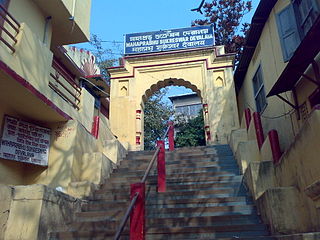
The Sukreswar (Pron: ˌʃʊˈkreɪʃwə) Temple is an important Shiva temple in the state of Assam in India. The temple is located on the Sukreswar or Itakhuli hill on the south bank of river Brahmaputra in the Panbazar locality of Guwahati city. Leading down from the temple compound is a long flight of steps to the river. Sitting on the steps of Sukreswar ghat one can enjoy the scenery of sun setting on the river, boats moving across the river, people performing puja in honour of their relatives who have left this world, children and older people bathing. It has one of the largest Lingam of Lord Shiva.

Sunenphaa also, Pramatta Singha, was the king of Ahom Kingdom. He succeeded his elder brother Swargadeo Siva Singha, as the king of Ahom Kingdom. His reign of seven years was peaceful and prosperous. He constructed numerous buildings and temples. The most famous of his buildings was the Rang Ghar, which is also considered as the oldest amphitheatre in Asia.

The Rudreswar Temple or Devaloya is a temple dedicated to Lord Shiva in the village of Rudreswar, under Sila Sindhurighopa Mouza, on northern bank of the river Brahmaputra, in Guwahati. Built in 1749 CE by Ahom king Pramatta Singha, in memory of his father Swargadeo Rudra Singha, the temple is a fine example of a mixed style of Ahom-Mughal architecture.
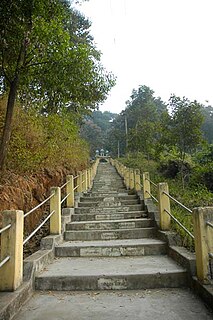
Lankeshwar {(Pron: ˈlæŋˌkeɪʃwə } Temple is an ancient Shiva temple on top of a hill in the western part of the Guwahati city near the campus of Gauhati University. The Lankeshwar Temple of Assam is an ancient temple dedicated to Lord Shiva. The temple is placed atop a hill amidst a picturesque location. Lankeshwar is one of the many forms of Lord Shiva. The followers of Lord Shiva considered the temple as one of the most sacred one. Devotees all around the year visit this temple and seek divine blessings.

Assam is the main and oldest state in the North-East Region of India and as the gateway to the rest of the Seven Sister States. The land of red river and blue hills, Assam comprises three main geographical areas: the Brahmaputra Valley which stretching along the length of the Brahmaputra river, the Barak Valley extending like a tail, and the intervening Karbi Plateau and North Cachar Hills. Assam shares its border with Meghalaya, Arunachal Pradesh, Nagaland, Manipur, Tripura, Mizoram and West Bengal; and there are National Highways leading to their capital cities. It also shares international borders with Bhutan and Bangladesh and is very close to Myanmar. In ancient times Assam was known as Pragjyotisha or Pragjyotishpura, and Kamarupa.
Basistha (Pron: bəˈsɪsθə) temple, located in the south-east corner of Guwahati city, Assam, India, is a Shiva mandir. The history of the Basistha Ashram where the temple is located dates back to the Vedic age. According to legend the ashram was founded by the great saint Basistha (Vasishtha).

The 2009 Guwahati bombings occurred on 1 January 2009 in Guwahati, Assam, India. They occurred a few hours before Indian Home Minister P. Chidambaram was due to travel to the city.
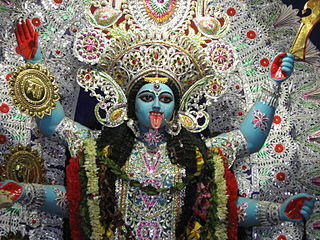
Kali Puja, also known as Shyama Puja or Mahanisha Puja, is a festival, originating from the Indian subcontinent, dedicated to the Hindu goddess Kali, celebrated on the new moon day of the Hindu month Kartik especially in the regions of West Bengal, and in Mithila region of Bihar, Odisha, Assam, Tripura, neighbouring country Bangladesh, and the town of Titwala in Maharashtra. Kali Puja is extremely popular in Nabadwip, Santipur, Tamluk, Barasat, Naihati, Barrackpore, Dakshineshwar and Tarapith in West Bengal. Begusarai, Munger, Bhagalpur in Bihar. Guwahati in Assam, Udaipur in Tripura, Ganjam in Odisha, Dhaka and Chittagong in neighbouring country of Bangladesh. It coincides with the Lakshmi Puja day of Diwali. While the Hindu Bengalis, Odias, Assamese and Maithils worship the goddess Kali on this day, the rest of India and Nepal worships goddess Lakshmi on Diwali.

The Ambubachi Mela is an annual Hindu mela (gathering) held at Kamakhya Temple in Guwahati, Assam. This yearly mela is celebrated during the monsoon season that happens to fall during the Assamese month Ahaar, around the middle of June when sun transit to the zodiac of Mithuna, when the Brahmaputra river is in spate.
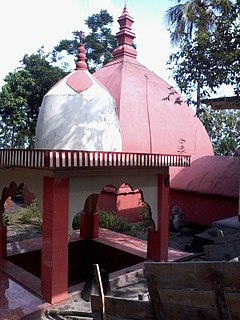
Dirgheswari Mandir is a temple situated in the northern banks of the river Brahmaputra in Guwahati, Assam,India. Many ancient images made on rocks existed along with the temple. Brick temple was Built by Ahom king Swargadeo Siva Singha, Dirgheswari temple is considered as a Shakti Peetha for Shakti Worship. The main attraction of Dirgheswari temple is the annual Durga Puja celebrations, in which devotees from far of places use to attend.

Northeast India consists of the eight states Arunachal Pradesh, Assam, Manipur, Meghalaya, Mizoram, Nagaland, Sikkim and Tripura. Tourism in this area is based around the unique Himalayan landscape and culture distinct from the rest of India.






















